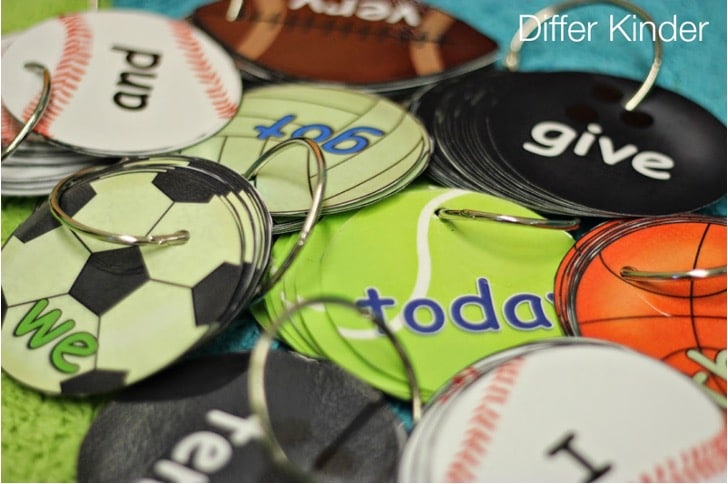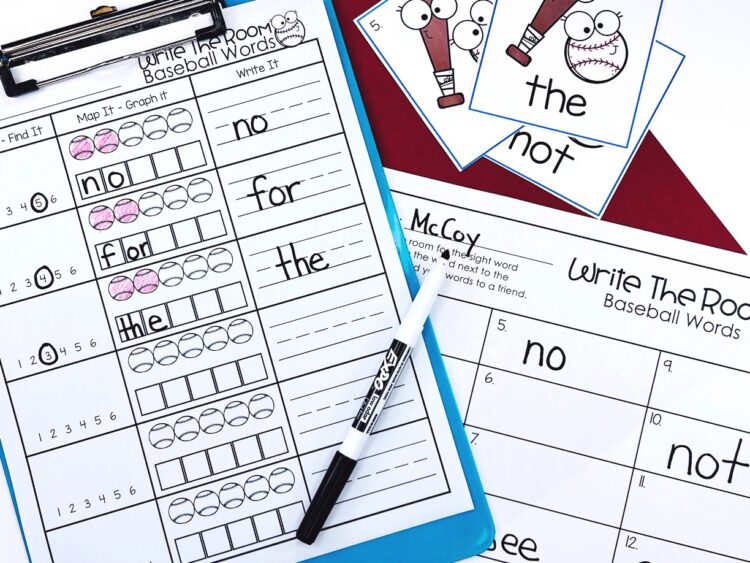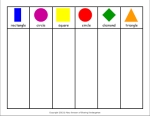Sight word instruction has come a long way from the days of handing out a list of words to students and telling them to memorize them. We know now, through the Science of Reading, that there is a better way for students. In order to help my readers with this, I have given Ball Words a facelift. When you know better you do better. So let me introduce you to the ‘new’ Ball Words’ and show you some of the changes that will help your students become Ball Word Champs.

A Little Background On Ball Words
Years and years ago, when I first started teaching, I was having a terrible time motivating my students to learn sight words. It just wasn’t happening. That first year, I had 20 boys in my class and 4 girls and all of them were involved in our local community’s youth sports programs. They all played soccer and T-ball and hockey and tennis and you name it. This class was full of kids that loved to play. So I came up with an idea to put the words that they needed to learn on balls.
I put the first 20 words on baseballs. The next 20 words went on soccer balls. Then the next 20 on basketballs and so on for a total of 11 sets of ball words or 220 words. When students could read the first set of words to me fluently, they would get a certificate and a trip to my treasure box. When no one wanted to practice and learn sight words before, suddenly everyone wanted to be a ball word champ. Just goes to show you . . . novelty has a way of motivating and engaging kids.
A lot has changed since those first ball words became part of my classroom. I have added games, activities, and fine motor building mats to my ball word repertoire. And once again, as things change and we all learn more, I like to make revisions and improve on products that need it. So that brings us to my latest revision of Ball Words. If you already own it, go redownload all these great new activities for free. If you don’t own it yet, read on to see if it’s something you might need.
Everything Old Is New Again
So you may be wondering, what is it that makes this revised version so different from the old, right? It’s a lot so let me try and break it down for you as easily as possible. If you are a current card-carrying member of the Ball Word Fan Club, don’t worry. Your favorites are still included along with a ton of new games and activities.
The Files
When you first download the new zip file, you are going to find four files within:
- READ THIS FIRST -BASEBALL file – This will be the file to open first. It will explain where everything is located and how to use the files included here. Don’t skip this and refer back to it often as needed. Based on what you read in this file, you will decide which of the other options you would like to use.
- Editable PDF File – This file will allow you to enter your words as a list and the games and activities will automatically populate. It’s super easy. However, you can not change the font colors or sizes of this file. Your words will automatically adjust to the size of the text box.
- Editable Powerpoint File – This file is for those teachers that want to change the font color, type or size that is displayed on their balls. It also will allow you to add a ‘heart’ above sight words with irregular spelling which is perfect for classrooms that use ‘heart words.’
- Power File for Mapping Words – This is the only place where you will find the Mapping Words Self-Correcting activity. This file allows you to add your own words for mapping and there is an option for you to even add ‘hearts’ if you use ‘heart words’ in your class.
The Balls
Remember, each set of balls has your own, district-approved or self-selected set of words. These can be all irregularly spelled words or a mixture of irregular and decodable. My list includes both. Just a tip for you, we know that before students start reading words, they need to have a strong foundation of phonological skills and also letter-sound association. With that in mind, try to select words with letters that your students have learned. So for instance, I would not add the word ‘but’ to my list if my students have not yet been taught and have learned that the letter ‘u’ makes the /u/ sound.
I generally like to make two copies of each set of balls and place them on a ring for students to use as needed. But I also make an extra copy so that when I post my words on the wall, they can see those ball words there as well.
Mapping Sight Words
Before students are offered a set of words to learn, those words are mapped out several times. I follow a very predictable routine for mapping so that my students can follow along with me and feel confident when learning new words. This is done through Orthographic Mapping. Orthographic mapping is the mental process that is involved when readers take unfamiliar words and turn them into words that are instantly and effortlessly retrieved from their memory. This mapping helps them make connections and recognize patterns in words. Students learn to decode these words and once the brain is familiar with the patterns, it recognizes the word so it doesn’t have to be sounded out each time. If you’d like to know exactly what it looks like when I introduce new sight words to might class, please check out my blog post Mastering Sight Words Through Mapping by clicking HERE.
As students become more familiar with the process of mapping, they can practice this activity with me during small group guided instruction and independently. When practicing independently, these self-correcting cards and mats give students instant feedback. If you are a teacher that uses heart words and likes the idea of students indicating the parts of irregularly spelled words that they have to ‘remember by heart,’ this file gives you that option as well.
The Sight Word Games and Activities
There are so many games and activities included in this set to help students stay engaged and learn through play. The best part is that by typing in your words on a list, the games automatically get populated. It makes it so easy peasy to personalize all these fun games. Check out what you will see in each set.
Board Game
For this board game, students spin the spinner to determine which color they move to on the board. They must read the word correctly or stay where they are.
Hide and Seek Game
One student hides the ‘special’ card behind the ball words in a pocket chart while other students hide their eyes. Then they take turns guessing where the card is hidden by reading the words on the cards.
Ball Word Memory
Played like traditional memory but with sets of small ball words. Students take turns turning over two cards. They read the two cards and if they match, they keep them and go again. If they don’t, the flip them back over for the next person. Play continues until all the cards are matched.
Ball Word Bingo
This game is played much like traditional Bingo. One student or a teacher will say a ball words and students will search their card to see if they can find it. They place a marker on any words they find. When they get a row across or diagonally or down, they yell Bingo.
Read and Keep Game
Students take turns drawing a card out of a bucket. If they read the card correctly, they keep it. If they do not, it goes back into the bucket. There are special playing cards to make play more fun and engaging. You never know who will win.
Roll, Say, Keep
Cards are placed on a playing mat. Students take turns rolling the dice. They read the card on the corresponding number. If they read it correctly, they keep the card. If not, the card stays in the box. There are special cards to make play more engaging and challenging.
Zap It Type Card Games
Cards are placed face-down on a table or floor. Students take turns drawing a card and reading it. If it is read correctly, then they keep it. If not, it goes back to the table and the cards are mixed up. In every set, there is also a ‘zap it’ type card. If students draw this card, all the cards they have won will go back on to the table and are mixed in. Students play until all the cards are gone.
Write the Room
This activity is especially engaging for kinesthetic learners. Cards are hidden around your room in various places. Students travel around the room searching for cards and completing a response sheet. There are two different response sheets from which teachers can choose. One has students mapping and recording words. The other is just recording words. Once recording sheets are completed, students read their words to a friend.
I Spy Activity
Students use a magnifying glass to find this laminated picture and record the words they find. They read their words to a friend when done.
Dough Mats
Great for getting those fine motor muscles working, this dough mat helps students build words on their ball list. Each mat has a ball in the corner for easy organization.
Hidden Words
In this printable version, students use a magnifying glass to find the hidden ball words, then they record the words they find and read them to a friend. When they are done, they can color the picture.
Color By Code
Students color the picture according to the code. Then they write the words and read them to a friend.
The Extra Stuff
Over the years, there have been extra items I have added to these sets to make things easier and to make celebrating students’ success a bit more fun.
Class Recording Sheet – Certificate – Ball Word Posters – Brag Tags
Personally, I prefer to keep track of student progress using ESGI software. However, I understand that using that software may not be an option for everyone. For that reason, I do have a recording sheet included in this set that you can use for keeping track of who has and hasn’t passed words.
I laminate these certificates to make them feel a bit more ‘official’ and special. Students also get a trip to my treasure box when they pass a level of ball words.
Their names also go up on my Ball Word Wall of Fame. If you don’t have a lot of space for this you can also just have students sign their names to a laminated Ball Word poster. It still feels special and this is an easy way for them to see where they have been and where they are headed.
And finally, I also offer them a brag tag for each level they pass. You can use all of these things, some or none. It is really up to you how you celebrate students’ success. Just make sure you do celebrate!

Take Home List, Editable Parent Letter – Parent At Home Activity Suggestions
Parents want to help their students learn their words. However, parents remember how they were taught sight words, and without guidance, they will ‘teach’ their child they way they were taught. ‘You can’t sound it out.” “You just have to memorize it.” For this reason, I never just send home a list of ball words with students. Lists are sent home a sight words introduction letter and a list of ways to practice words at home. As students progress through lists, I am very careful to map out any list of words with them before sending them home.
Storage and Organization of Ball Word Sight Word Materials
As your students start using ball words and all the corresponding activities that go with each level, it will be important to have a really good organizational system for keeping items separated. While I have used a different drawer system in the past, this 10-drawered system has worked the best for me. I can select games that I want students to use and place them in each corresponding drawer. Students know which ball word level they are working on at any given time. So when it’s time for sight word practice, they would go over to the drawer with their ball word level and select an activity.

If you would like to have a set of these drawer labels, you can grab them HERE.

Play Ball
If you’re interested in finding out more about ball words, you can check them out by clicking on the picture below.
Pin It
If you found this blog post helpful, please consider pinning it so others can see it, too.

























Leave a Reply